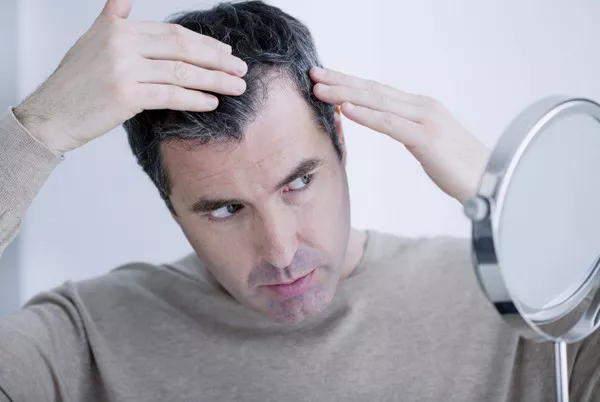Male pattern baldness, also known as androgenetic alopecia, is a common condition that affects a significant percentage of men as they age. Characterized by a gradual thinning of the hair and a receding hairline, male pattern baldness can have a significant impact on self-esteem and overall well-being. Understanding the underlying causes of this condition is crucial for developing effective treatment strategies and managing its effects. While genetics play a significant role in the development of male pattern baldness, there are several other factors that contribute to its onset and progression. Here’s a comprehensive look at the causes of male pattern baldness and how it affects men.
1. Genetics and Family History:
One of the primary causes of male pattern baldness is genetic predisposition. If you have a family history of male pattern baldness, you are more likely to experience hair loss as you age. This condition is often passed down through generations, with specific genes playing a crucial role in determining the susceptibility to hair loss. The inheritance pattern can vary, and the severity of the condition can differ from one individual to another.
2. Hormonal Changes:
Hormonal changes, particularly the presence of dihydrotestosterone (DHT), contribute to the development of male pattern baldness. DHT is a byproduct of testosterone, and its increased production can lead to the shrinking of hair follicles over time. This process, known as miniaturization, results in shorter and finer hair strands, eventually leading to a significant decrease in hair density and coverage. Hormonal imbalances can accelerate the progression of male pattern baldness, causing more pronounced hair loss in affected individuals.
3. Age-Related Factors:
As men age, the natural aging process can contribute to the development of male pattern baldness. With increasing age, the hair growth cycle becomes shorter, leading to the gradual thinning and weakening of hair follicles. The reduction in the production of essential proteins and nutrients necessary for healthy hair growth can also play a role in the progression of male pattern baldness. While not all men will experience significant hair loss as they age, the aging process can exacerbate the condition in those predisposed to male pattern baldness.
4. Stress and Lifestyle Factors:
Stress and certain lifestyle factors can contribute to the onset and progression of male pattern baldness. Chronic stress can disrupt hormonal balance and increase the production of DHT, leading to the accelerated thinning of hair follicles. Unhealthy lifestyle choices, such as smoking, excessive alcohol consumption, and a poor diet, can also contribute to the weakening of hair follicles and the progression of male pattern baldness. Maintaining a healthy lifestyle and managing stress levels can help slow down the progression of hair loss and promote overall well-being.
5. Medical Conditions and Treatments:
Certain medical conditions and treatments can also contribute to the development of male pattern baldness. Conditions such as thyroid disorders, autoimmune diseases, and scalp infections can disrupt the normal hair growth cycle and lead to excessive hair shedding. Additionally, treatments such as chemotherapy and radiation therapy can result in temporary or permanent hair loss, exacerbating the effects of male pattern baldness in affected individuals.
6. Impact on Men:
Male pattern baldness can have a significant impact on the emotional well-being and self-esteem of affected individuals. The gradual loss of hair can lead to feelings of self-consciousness and a negative body image, affecting social interactions and personal relationships. Many men experience a decline in confidence and self-assurance, especially when dealing with the visible signs of hair loss. While male pattern baldness is a common condition, its psychological effects should not be overlooked, and individuals affected by this condition may benefit from seeking support and guidance to cope with the emotional impact of hair loss.
FAQs About Male Hair Loss:
Q1: Is male pattern baldness reversible?
A: While male pattern baldness is not completely reversible, there are several treatment options available that can help slow down the progression of hair loss and promote hair regrowth. Treatments such as minoxidil, finasteride, and hair transplant surgery can effectively address male pattern baldness and improve the appearance of the hair.
Q2: Can stress contribute to male pattern baldness?
A: Yes, chronic stress can contribute to the acceleration of male pattern baldness. Elevated stress levels can disrupt hormonal balance and increase the production of dihydrotestosterone (DHT), leading to the gradual weakening of hair follicles and subsequent hair loss. Managing stress through relaxation techniques and healthy lifestyle choices can help mitigate the effects of male pattern baldness.
Q3: Are there any preventive measures for male pattern baldness?
A: While male pattern baldness cannot be entirely prevented, maintaining a healthy lifestyle and managing stress levels can help slow down the progression of hair loss. Additionally, early intervention with appropriate treatments, such as minoxidil or finasteride, can help preserve hair density and promote healthy hair growth.
Q4: Can dietary changes help with male pattern baldness?
A: Yes, making dietary changes and incorporating essential nutrients such as vitamins, minerals, and proteins can promote healthy hair growth and minimize the effects of male pattern baldness. Consuming a balanced diet rich in fruits, vegetables, lean proteins, and whole grains can provide the necessary nutrients for maintaining strong and healthy hair.
Q5: How can individuals cope with the emotional impact of male pattern baldness?
A: Coping with the emotional impact of male pattern baldness involves seeking support from friends, family, or a mental health professional. Engaging in open discussions about personal concerns and exploring coping strategies, such as practicing self-care, pursuing hobbies, and maintaining a positive self-image, can help individuals manage the emotional effects of hair loss and maintain a healthy sense of self-esteem.

